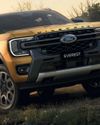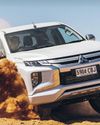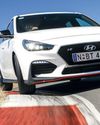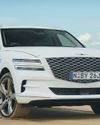
As it is, the good people at Toyota have been taken aback by the little hot hatch's popularity. They've now made 32,000 of them, and counting.
Not only has that justified this facelift, which Toyota didn't imagine it would ever be in a position to produce, but it also means they've now committed to the GR Yaris for the longer haul. So long as Toyota can sell them (not a given in the UK or EU, given emissions limits), it will keep making them.
In the meantime, they've also been rallying and circuit racing it - and discovering its limitations - which have played into this facelift. They've crashed it, melted it, and burnt it so that you don't have to. The headlines are that there's now more power and there's the long-awaited option of an automatic gearbox, but the detail changes run much deeper.
At the front, the bumper is now made in three pieces, rather than one, so that it's quicker to replace a corner if you nerf it off on a racetrack.
The centre section includes a larger cooling aperture, necessary for engine durability, and its grille is now made of metal, rather than plastic, so that debris doesn't burst through it, exposing the radiator to holing the next time it happens.
At the rear, the low-level reversing light has been moved level with the other lights - hot exhausts could and have melted it - and the high-level brake light has been moved from the spoiler to the rear window, because it was upsetting tuners who fitted their own rear wings.
My test cars here are disguised, but I'm told that otherwise the visuals including 18-inch wheels with 225/40 Michelin Pilot Sport 4S rubber - are largely unchanged.
The body changes are ones you can't see. There's a 15 percent increase in the number of spot welds and a 15 percent increase in the adhesive used to stiffen the shell. Weight is unchanged, at 1280kg. The front struts are now more securely mounted by three bolts, rather than one larger one.
This story is from the February 2024 edition of Wheels Australia Magazine.
Start your 7-day Magzter GOLD free trial to access thousands of curated premium stories, and 8,500+ magazines and newspapers.
Already a subscriber ? Sign In
This story is from the February 2024 edition of Wheels Australia Magazine.
Start your 7-day Magzter GOLD free trial to access thousands of curated premium stories, and 8,500+ magazines and newspapers.
Already a subscriber? Sign In

ROUGH DIAMONDS
GO OUT AND SEE AUSTRALIA. BUY ONE OF THESE AND YOU'LL MAKE IT HOME TOO

WORK IN PROGRESS
WHEN YOUR LIVELIHOOD DEPENDS ON IT, DON'T TAKE ANY CHANCES

RABID RESPONSE
EVEN IF YOU'RE PULLING IN THE FINANCIAL HORNS, YOU WON'T NEED TO COMPROMISE ON FUN

PREMIUM BLEND
HERE'S HOW TO ENJOY CHAMPAGNE ON A VAGUELY BEERY BUDGET

GO LARGE, SAVE BIG
WE BRING YOU A SELECTION OF LARGE FAMILY SUVS THAT ARE UNLIKELY TO BREAK THE BANK

MIDDLE CLASS
THE AUSSIE FAMILY DREAM USED TO BE A QUARTER ACRE AND A PICKET FENCE. NOW IT'S A LITTLE MORE MODEST

SHORTY AWARDS
VALUE FOR MONEY CAN BE A RARE COMMODITY AMONG SMALL SUVS. HERE ARE THREE THAT ANSWER THE CALL

MID SIZE MAX VALUE
THE MEDIUM RANGE SECTOR IS THE VERY DEFINITION OF GETTING ALOT OF CAR FOR YOUR DOLLAR

HATCH MATCH
WANT A HATCH THAT'LL PUT A SMILE ON YOUR DIAL SECOND TIME ROUND? TRY THESE...

MODE ΤΟ ΤΟΥ
PORSCHE'S LATEST HOT 911 IS THE NEW FRONTIER FOR ON-THEFLY CHASSIS ADJUSTABILITY, OFFERING THE DRIVER A WORLD OF CONFIGURATION - BUT IS IT WORTH THE HASSLE?